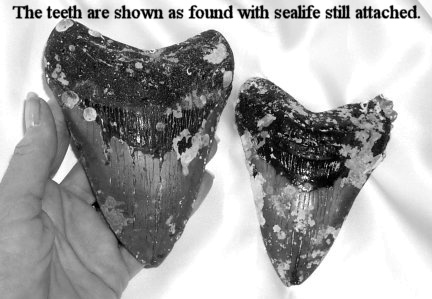|
Diving For Shark Teeth Offshore Of South Carolina |
|
By Charlotte Lloyd |
|
|
|
I guess if you are a true “collector” then your interests probably include more than one area. For over 40 years I have been avid about seashells, however, I also love and collect antiques and have always had an interest in fossils. For several years now my sons Jimmy and Brian have been fishing/diving the reefs offshore of Georgetown, South Carolina and coming home with large fossilized shark teeth. For several years I have been planning a trip to dive with them and join the hunt. In August I finally got the chance. The day before I was to drive up to South Carolina my son called and said, “Mom, you better bring a wetsuit because it is chilly on the bottom.” As much as I hate it, I would bring the dreaded suit and of course a collecting bag for all of the shark teeth I was going to find. I met their boat F/V Reef Raider II at 6:00 AM at the dock with my dive gear, camera, lunch, and high hopes. We were soon under way and headed out Black River to Waynea Bay, the entrance to Georgetown from the open sea. The trip to the coast takes about one and a half to two hours depending on which way the current is running. This trip takes one by a wildlife preserve at North Island and the Georgetown Lighthouse where scheduled boat trips take folks to collect shells. Once we saw South Rock Jetties we headed ESE for the 30-mile run to 110 feet of water.
The teeth we found are from an extinct shark, Carcharodon megalodon, which were probably 50 feet or more in length. This giant shark was named by Agassiz in 1843. Carcharodon (meaning "rough tooth") or Carcharocles. (There is currently some debate as to whether the megalodon's genus should be Carcharocles or Carcharodon. Megalodon was once thought to be a direct ancestor of the white shark, Carcharodon carcharias, and so was put in the same genus; new evidence indicates that it is not ancestral to the great white shark, so Megalodon was assigned to a new genus, Carcharocles.) Megalodon teeth up to 6.5 inches (17 cm.) long have been found in Europe, India, Oceania (the general area around Australia including New Zealand, New Caledonia, etc.), North America, and South America. Megalodon lived from roughly 25 to 1.6 million years ago, during the Miocene and Pliocene epochs. It is now extinct, but the exact time of its extinction is hotly debated. Next year I hope to again dive for teeth, maybe the water will be clearer, warmer and lady luck will bestow us with more exceptional finds. |
 The dive spot was located, the boat anchored, and we suited up to dive. Over the
years I had done a lot of diving for shells offshore of the
Charleston/Georgetown area and remembered the pretty reefs with Spondylus,
tropical fish, and warm water. At the surface the water temperature was a
pleasant 78 degrees. On the way down the anchor line we went through a
thermocline of cold water at about 45 feet. We encountered another at 80 feet
with a drastic loss of visibility. By the time we reached the bottom the water
temperature registered about 62 degrees and visibility had dropped to 6 to 10
feet. Not pleasant diving conditions! It is very easy to lose your dive partner,
the anchor line, and to become disoriented in dirty cold water. I had been told
to search the areas away from the reefs and to look in rubble where currents had
washed away the sand. If I found a tooth I knew to search the area nearby
because if the shark had died and fossilized in that spot the chances of finding
more teeth were greatly increased. This proved to be true; I found two 5-inch
teeth within three feet of each other. Later in the dive I located a smaller
4-inch tooth. My second dive of the day only produced chill bumps for me, but my
experienced sons found several nice specimen teeth.
The dive spot was located, the boat anchored, and we suited up to dive. Over the
years I had done a lot of diving for shells offshore of the
Charleston/Georgetown area and remembered the pretty reefs with Spondylus,
tropical fish, and warm water. At the surface the water temperature was a
pleasant 78 degrees. On the way down the anchor line we went through a
thermocline of cold water at about 45 feet. We encountered another at 80 feet
with a drastic loss of visibility. By the time we reached the bottom the water
temperature registered about 62 degrees and visibility had dropped to 6 to 10
feet. Not pleasant diving conditions! It is very easy to lose your dive partner,
the anchor line, and to become disoriented in dirty cold water. I had been told
to search the areas away from the reefs and to look in rubble where currents had
washed away the sand. If I found a tooth I knew to search the area nearby
because if the shark had died and fossilized in that spot the chances of finding
more teeth were greatly increased. This proved to be true; I found two 5-inch
teeth within three feet of each other. Later in the dive I located a smaller
4-inch tooth. My second dive of the day only produced chill bumps for me, but my
experienced sons found several nice specimen teeth.